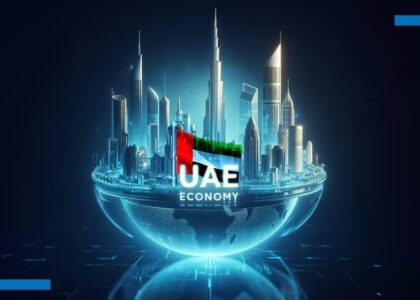Before discussing the DFM, let’s note that Dubai has become a vibrant financial hub, It offers investors access to regional and international markets, The city’s strategic location, political stability, and pro-business policies have made it an attractive destination for investors seeking to tap into the region’s vast potential.
At Dubai’s financial ecosystem’s core is the Dubai Financial Market (DFM), Established in 2000, DFM was the UAE’s first stock exchange, Since then, it has significantly driven economic growth and supported the country’s capital markets’ development.
You can Read More: Bitcoin Halving: In The Near Future
Historical Overview and Milestones in DFM
In reality, DFM’s journey began in March 2000 as the UAE’s first stock exchange, Starting with just nine listed companies, it quickly expanded its listings.
After that, In 2003, DFM launched an electronic trading platform, This enabled more efficient and transparent stock and securities trading.
Then, By 2005, the exchange had introduced a clearing and settlement system. This enhanced its operational efficiency and reliability.
In 2007, DFM completed its listing on the exchange, It became the first UAE-based financial institution to go public, This move marked a significant milestone, highlighting its commitment to transparency and accountability, Since then, DFM has continued to expand its offerings and services, It caters to the evolving needs of its stakeholders.
Read also: Safe Haven Shines: Gold Breaks Record Amid Rate Cut Speculation
Key Players and Stakeholders IN DFM
DFM is governed by a board of directors, consisting of seasoned professionals from various sectors. The exchange’s management team comprises experts with extensive industry experience. They are responsible for the day-to-day operations of the exchange.
Apart from the stakeholders directly involved with the exchange, DFM’s ecosystem includes a range of players. These include brokers, market makers, custodians, and other service providers. Each contributes to the market’s smooth functioning, enabling investors to trade and access capital as needed.
Read More: We glad to discuss your Financial Planning.
Market Structure and Operations IN DFM
DFM follows a two-tier market structure. The primary market facilitates the listing of securities, and the secondary market enables their trading. The exchange offers a wide range of products, including equities, bonds, and mutual funds. These cater to the diverse needs of investors.
DFM operates under international best practices. It adheres to strict disclosure and reporting requirements. The exchange has implemented robust risk management frameworks. These ensure the market’s safety and soundness.
Read also: The Future of Finance in Developing Countries
Regulatory Framework and Compliance IN DFM
DFM is regulated by the Securities and Commodities Authority (SCA), and The SCA is the overarching regulatory body overseeing the UAE’s capital markets, It has established a comprehensive framework for regulating the securities industry, This covers areas such as listing requirements, disclosure norms, and investor protection, In line with global regulatory trends, DFM has adopted several measures aimed at enhancing transparency and mitigating risks, These include the implementation of a central counterparty clearinghouse, the introduction of short-selling regulations, and the deployment of real-time surveillance systems.
Reed more: Secrets Your Business Mentor Won’t Tell You
Technological Innovations and Digital Transformation
DFM has been at the forefront of the digital transformation of the UAE’s capital markets, It leverages technology to enhance operational efficiency and drive innovation, The exchange has introduced several initiatives aimed at digitizing the market, These include the deployment of blockchain technology and the launch of a mobile trading app, DFM has also established a dedicated innovation lab, This lab fosters collaboration with technology firms and startups, It enables the exchange to explore new business models and identify emerging market trends.
Read More: Top Listed Business Development Program
Investment Opportunities and Market Trends
DFM offers investors a range of investment opportunities, It caters to both retail and institutional investors. The exchange has a diverse issuer base, including companies from sectors such as banking, real estate, and healthcare. The exchange has also witnessed heightened interest from foreign issuers seeking to tap into the region’s growth potential.
In recent years, DFM has emerged as a strong performer, It registers consistent growth and attracts considerable foreign investment, The exchange has also witnessed an increased appetite for sustainable investments, Issuers and investors are embracing environmental, social, and governance (ESG) principles.
Read also: Main Reason to Expand Fast Business Builder.
Challenges and Risks IN DFM
Like any financial market, DFM faces several challenges and risks, These range from geopolitical uncertainty to market volatility, The exchange has also had to navigate the impact of the COVID-19 pandemic, This has disrupted global financial markets and upended traditional investor behavior.
DFM’s ecosystem has also witnessed the emergence of several disruptors, These include fintech firms and neobanks, They offer alternative investment options and challenge the traditional business models of incumbents.
Read More: Successful Growth in Financial Investment
Global Impact and Future Prospects
DFM’s impact extends beyond the UAE, The exchange plays a pivotal role in attracting foreign investment to the region, It also enhances financial literacy and promotes investor education in the region.
Looking ahead, DFM is well-positioned to capitalize on the region’s growth prospects and emerging technology trends. The exchange has laid the groundwork for continued innovation and expansion. Initiatives aimed at enhancing market liquidity and enabling access to new asset classes are in place.
Read also: Business Team Response After Crisis
Conclusion: The Road Ahead for DFM
Dubai Financial Market or DFM is a vital cog in the UAE’s financial ecosystem. It provides investors with a gateway to the region’s economic potential. The exchange has navigated several challenges over the years. It has emerged as a reliable and transparent institution.
As the region continues to evolve, DFM will need to stay nimble and responsive to changing market dynamics. The exchange’s commitment to innovation and digital transformation will be critical. It will enable DFM to remain relevant and competitive in the years ahead.
You can Read More: Business Team Response After Crisis






